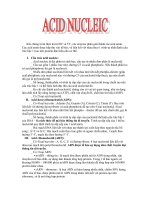Carboxylic acid – ester – propanoic acid methyl ethanoate
Bạn đang xem bản rút gọn của tài liệu. Xem và tải ngay bản đầy đủ của tài liệu tại đây (1.2 MB, 41 trang )
Chapter 14
Carboxylic Acids and Carboxylic
Acid De rivative s
Denniston
Topping
Caret
5
th
Edition
Copyright The McGraw-Hill Companies, Inc. Permission required for reproduction or display.
Functional Group Formulas
14.1 Carboxylic Acids
Structure
•
Carboxylic acid groups consist of two
very polar functional groups
–
Carbonyl group
–
Hydroxyl group
•
Carboxylic acid groups are very polar
Carboxylic acid – Ester –
propanoic acid methyl ethanoate
Physical Properties
•
Low molecular weight carboxylic acids
–
Sharp, sour taste
–
Unpleasant aromas
•
High molecular weight carboxylic acids
–
Fatty acids important in biochemistry
•
Low molecular weight carboxylic acids are water
soluble due to hydrogen bonding with:
–
Water
–
Each other
14.1 Carboxylic Acids
Physical Properties
Due to carboxylic acids forming intermolecular
hydrogen bonds boiling points are at higher
temperatures than those of any other functional
group studied
14.1 Carboxylic Acids
Nomenclature
•
Determine the parent compound: 4C – butane
•
Number the chain so that the carboxyl carbon
is carbon 1: from right to left
•
Replace the –e ending with –oic acid
–
Butanoic acid
–
If two carboxyl groups are present use –dioic acid
•
Complete naming as usual – bromine on C-3
CH
3
CH CH
2
C
Br
OH
O
14.1 Carboxylic Acids
1234
Carboxylic Acid
Naming Examples
14.1 Carboxylic Acids
Common Names
•
Use Latin or Greek prefixes
•
Suffix is –ic acid
•
Greek letters indicate the position of the
substituents
14.1 Carboxylic Acids
Names and Structures of Some
Common Carboxylic Acids
14.1 Carboxylic Acids
Some Important Carboxylic Acids
CH
3
CH
2
C
O
OH
16
Stearic acid
found in beef fat
14.1 Carboxylic Acids
Reactions Involving
Carboxylic Acids
•
Carboxylic acids are prepared by
oxidation of primary alcohols and
aldehydes
CH
3
CH
2
CH
2
OH
CH
3
CH
2
CH
O
CH
3
CH
2
C
O
OH
H
2
CrO
4
Warm
14.1 Carboxylic Acids
Acid-Base Reactions
•
Carboxylic acids behave as acids because
when they are dissolved in water they will
deprotonate to form a carboxylate ion and
the hydronium ion
•
Carboxylic acids are weak acids with
dissociations of less than 5%
14.1 Carboxylic Acids
Acid-Base Reactions
•
Carboxylic acids DO react with strong
bases to form carboxylate salts
–
A process of neutralization
–
Acid protons are removed by the –OH
-
to form
H
2
O and carboxylate ion
–
Equilibrium shifts to the right with removal of
H
+
14.1 Carboxylic Acids
Using Acid-Base Reactions
•
What is the product of each of the following
reactions?
14.1 Carboxylic Acids
Salts of Carboxylic Acids
•
Nomenclature
–
First add the cation’s name
•
Sodium
–
Then drop the –oic acid and add –ate
•
Sodium benzoate
•
Uses of carboxylic acids
•
Soaps like sodium stearate
•
Preservatives
•
Anti-fungal medicines
•
Used to control food pH
14.1 Carboxylic Acids
Esterification
•
Carboxylic acids react with alcohols to form:
–
Esters
–
Water
14.1 Carboxylic Acids
14.2 Esters
Structure and physical properties
•
Esters are mildly polar, somewhat water soluble
•
Frequently found in natural foodstuffs
•
Many have pleasant aromas
–
Isoamyl acetate = banana oil
3-methylbutyl ethanoate
–
Ethyl butanoate = pineapple aroma
Ethyl butanoate
–
Isobutyl formate = raspberry aroma
Isobutyl methanoate
•
Boil at approximately the same temperature as
carbonyls with comparable molecular weight
Nomenclature
Form from the reaction of a carboxylic acid with an
alcohol, which is reflected in the naming
1. Use the alkyl group as the first name
(Alcohol part of the ester)
2. Base the name for the acid part of the structure
from the longest chain ending in the C=O
(Carboxylic acid part of the ester)
3. Change the –oic acid of the acid name to –oate
14.2 Esters
Naming Esters
Name the following esters:
•
Alkyl portion = first name ethyl
•
Parent carboxylic acid = butanoic acid
•
Change suffix to reflect ester = Ethyl butanoate
•
Alkyl portion = first name proply
•
Parent carboxylic acid = ethanoic acid
•
Change suffix to reflect ester = Propyl ethanoate
14.2 Esters
Naming Esters
Naming esters is much like naming the salts
of carboxylic acids:
•
Alkyl portion = first name ethyl
•
Parent carboxylic acid = ethanoic acid
•
Change suffix to reflect ester =
Ethyl
ethanoate
14.2 Esters
Reactions Involving Esters
Preparation
•
Carboxylic acids react with alcohols to produce esters
•
The reaction is catalyzed by strong mineral acid
•
Heat is required
•
A molecule of water is also released as a product =
reaction is a dehydration
+
CH
3
OH
H
3
O
+
H
3
PO
4
CH
2
C
O
OH
CH
3
CH
3
O
CH
2
C
O
CH
3
+ H
2
O
14.2 Esters
Hydrolysis of Esters
•
The main reaction of esters is hydrolysis,
reaction with water
–
This reaction is also called hydration =
cleavage of any bond by the addition of a
water molecule
•
However, the uncatalyzed reaction is
slow and requires heat
•
Mineral acid is used as a catalyst
14.2 Esters
Acid hydrolysis of Esters
Acid hydrolysis products are:
•
Acid
•
Alcohol
14.2 Esters
Base hydrolysis of Esters
The base catalyzed hydrolysis of an ester:
•
Saponification or soap-making
•
Products are:
–
Acid salt
–
Alcohol
•
Acid can’t exist in basic conditions, so
the product is the salt of the carboxylic
acid using the cation of the base catalyst
14.2 Esters
Saponification
•
Saponification (soap-making) is:
–
Base-catalyzed hydrolysis of fats (glycerol triesters)
14.2 Esters









